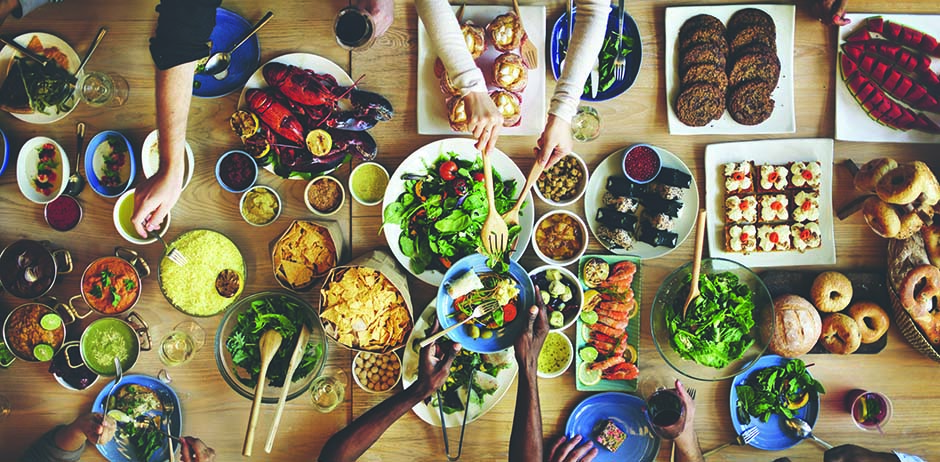The next time you sit down to a meal, take a good look at the foods on your plate. Is the chicken rubbed with Caribbean spices, or maybe rolled in Japanese panko crumbs? Perhaps you are about to tuck into a spicy Tex-Mex burrito or a bowl of Italian spaghetti? American meals have become a delicious compilation of unique dishes from around the world—so much so that some of these dishes have become as commonplace as, well, apple pie.
Over the centuries, waves of immigrants from Europe, Asia and the Americas have profoundly influenced what we eat, introducing dishes of their ancestors in their new country. Not only do we enjoy the benefit of new tastes and flavors, but the exposure to different cuisines offers the chance to learn new food combinations and preparation techniques, as well as an opportunity to connect with our ethnic roots.
“Food is often deeply ingrained in culture,” says Annika Stensson, director of research communications for the National Restaurant Association (NRA). “You may not be able to visit all the places around the globe from where your family originated, but sharing a meal of those cuisines right here at home is an accessible way to connect with your ancestry.”
Enjoy the Familiar
The NRA’s 2015 “Global Palates: Ethnic Cuisines and Flavors in America” study found that Italian, Mexican and Chinese are the best-known ethnic cuisines in the United States. Italian, in particular, is the most familiar and popular. The vibrant flavors of Italy—tomatoes, fresh herbs, garden greens and vegetables—can be easily grown in gardens, and there is good accessibility in grocery stores to cheeses, meats, poultry and fish, other popular Italian ingredients.
The fact that the American palate has easily adapted to Italian cuisine comes as no surprise to Elise Wiggins, executive chef of the acclaimed Panzano restaurant in Denver. Wiggins embraces the Slow Food Movement started in Italy to preserve traditional and regional
cuisine. Her backyard garden even includes a row of heirloom Italian broccoli that she is cultivating for the restaurant. But as often happens, she acknowledges, as Americans embrace an ethnic cuisine, they tend to put their own spin on it. “Spaghettini (pasta) is one of the things that is authentically classic Italian—it’s just that they don’t eat it with meatballs.”
Wiggins inspires her customers to learn more about genuine Italian cuisine by offering classes on different techniques and dishes at the restaurant. “I can offer classes on how to make tiramisu, breads, seafood, etc., but the best-selling class is always pasta-making,” she says. Taking a cooking class is a great way to learn about a culture and prepare a favorite dish to share the cuisine you enjoy so much with others.
Try Wiggins’ delicious Tomato and Watermelon Bruschetta.
Exploring the Exotic
More than ever, Americans are willing to venture beyond the more familiar ethnic cuisines. Research from the “Global Palates” study shows that two-thirds of Americans eat a wider variety of ethnic cuisines than they did just five years ago. But there are still many types of cuisines in the study that are not so well-known, including Ethiopian, Brazilian/Argentinian and Korean. Cathlyn Choi, also known as the “Korean Food Ambassador,” is working to shake that up.
When she first moved to the United States in 2000, she was surprised to learn that “most people didn’t have a clue as to what Korean food was,” she says. With the help of her husband, she started an educational Korean cooking show that is now on PBS.
“Cathlyn’s Korean Kitchen” became an instant hit. “There were a lot of talented Korean chefs, but none of them could cook, speak English and be comfortable in front of the camera,” Choi says. “‘Cathlyn’s Korean Kitchen’ was the first Korean cooking show on TV in English in the United States, so it got popular very fast.” Choi also performs cooking demonstrations at various cultural and food festivals throughout the year, including Let’s Move, a campaign first lady Michelle Obama initiated to prevent diabetes and obesity in children.
Because most Americans aren’t familiar with Korean food, Choi suggests dining at a Korean bar–becue restaurant. All entrees are served with various side dishes—mainly lightly sautéed, seasoned
or pickled vegetables; beans; some type of soup; leafy greens; and dipping sauces—which provide a broad exposure to Korean cuisine. (Bonus: Refills are free, Choi says.)
Choi likes to introduce Korean food by combining certain ingredients into meals that people are already familiar with—for example, tacos, hamburgers or spaghetti. One of her favorites is kimchi, a fermented cabbage dish that is the staple food of Koreans. “It’s considered one of the healthiest foods in the world, with all-natural probiotics, vitamins and minerals,” she says.
Try Choi’s flavorful Gochujang Beef Tacos with Kimchi Salsa.
As a nation nicknamed “the melting pot,” America provides a fascinating illustration of how infusing foods from other cultures into our culinary experiences radically influences our own culture. A fusion of flavors can be happily discovered throughout the country, taking root in our communities and kitchens in a variety of delectable dishes—and making us richer for it.
Gigi Ragland specializes in travel, sustainable topics, adventure and food writing.

